Analysis of Food Production and Consumption Based on the Emergy Method in Kazakhstan
Abstract
1. Introduction
2. Materials and Methods
2.1. Study Area
2.2. Data Collection
2.3. Analysis Methodology
3. Results
3.1. Food Production and Consumption Quantity and Their Change Trend
- (1)
- Total food production and consumption increase and pattern change
3.2. Changing Relationship between Food Production and Consumption
4. Discussion
5. Conclusions
Author Contributions
Funding
Institutional Review Board Statement
Informed Consent Statement
Data Availability Statement
Acknowledgments
Conflicts of Interest
Appendix A
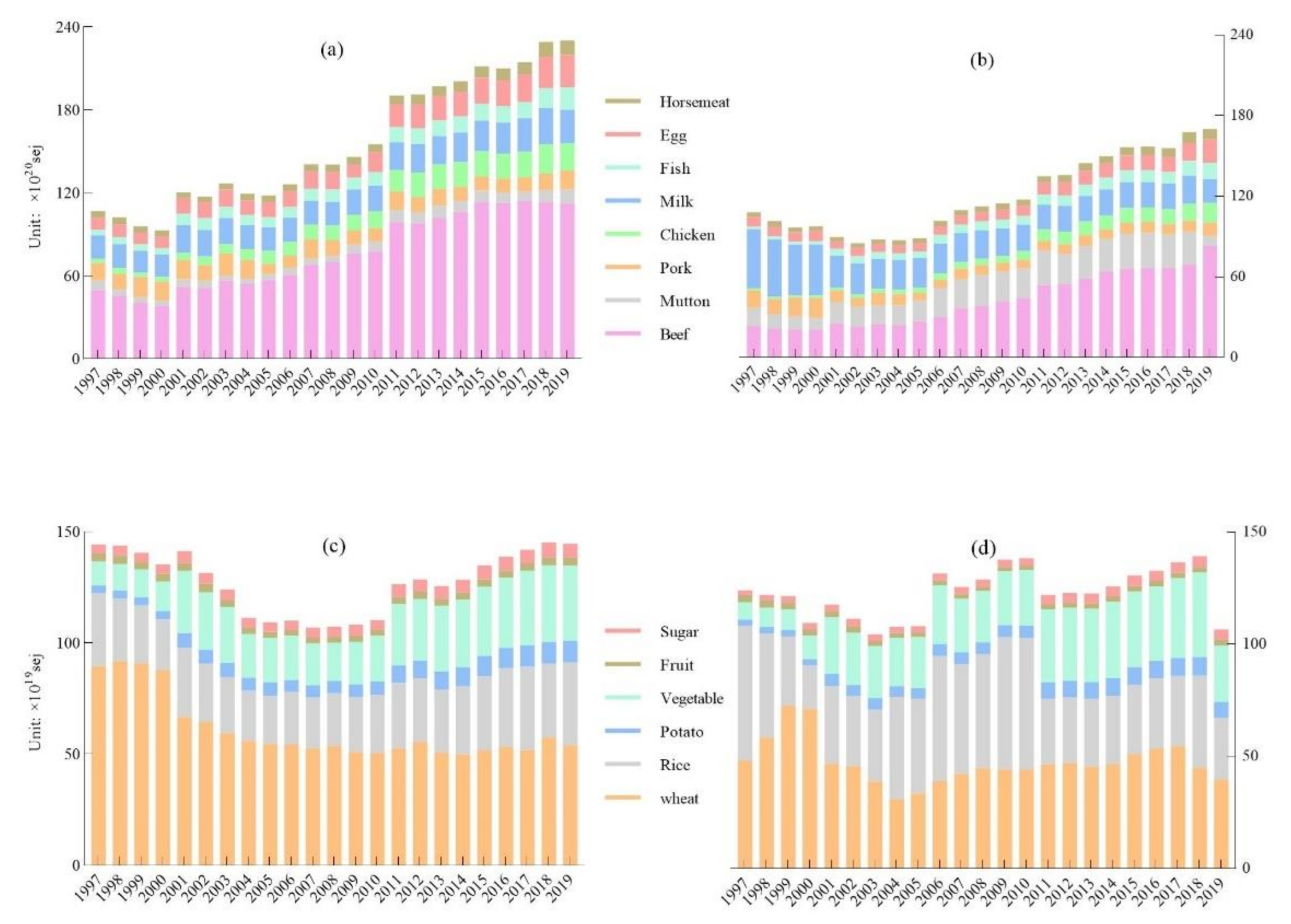
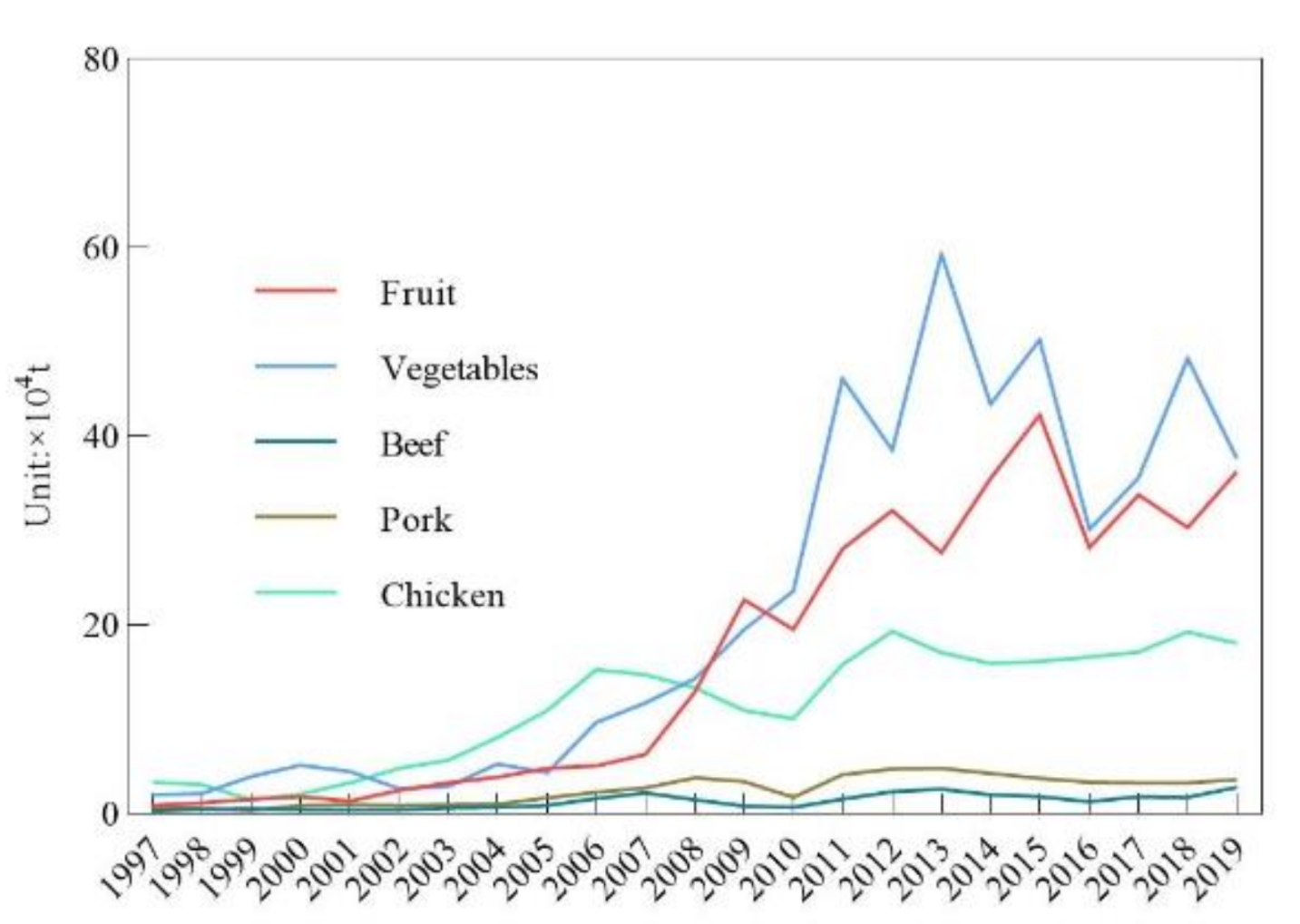
References
- Foley, J.A.; Ramankutty, N.; Brauman, K.A.; Brauman, K.A.; Cassidy, E.S.; Gerber, J.S.; Johnston, M.; Muller, N.D.; O’Connell, C.; Ray, D.K.; et al. Solutions for a cultivated planet. Nature 2011, 478, 337–342. [Google Scholar] [CrossRef] [PubMed]
- Tilman, D.; Balzer, C.; Hill, J.; Befort, B.L. Global food demand and the sustainable intensification of agriculture. Proc. Natl. Acad. Sci. USA 2011, 108, 20260–20264. [Google Scholar] [CrossRef] [PubMed]
- Jain, M.; Solomon, D.; Capnerhurst, H.; Arnold, A.; Elliott, A.; Kinzer, A.T.; Knauss, C.; Peters, M.; Rolf, B.; Weil, A.; et al. How much can sustainable intensification increase yields across South Asia? a systematic review of the evidence. Environ. Res. Lett. 2020, 15, 083004. [Google Scholar] [CrossRef]
- Rockstrom, J.; Williams, J.; Daily, G.; Noble, A.; Matthews, N.; Gordon, L.; Wettersrand, H.; DeClerck, F.; Shah, M.; Sterduto, P.; et al. Sustainable intensification of agriculture for human prosperity and global sustainability. Ambio 2017, 46, 4–17. [Google Scholar] [CrossRef]
- Buol, S.W. Sustainability of Soil Use. Annu. Rev. Ecol. Syst. 1995, 26, 25–44. [Google Scholar] [CrossRef]
- Reeves, T.G.; Pingali, P.L.; Rajaram, S.; Cassaday, K. Crop and natural resource management strategies to foster sustainable wheat production in developing countries. In Wheat in a Global Environment; Bedo, Z., Lang, L., Eds.; Springer: Dordrecht, The Netherlands, 2001; Volume 9, pp. 23–36. [Google Scholar]
- Speedy, A.W. Global production and consumption of animal source foods. J. Nutr. 2003, 133, 4048S–4053S. [Google Scholar] [CrossRef] [PubMed]
- Kalamkarova, L.I.; Bagryantseva, O.V. The problem of food-products safety in Kazakh Republic. In Impact of Pollution on Animal Products; Faye, B., Sinyavskiy, Y., Eds.; Kazakh Academy of Nutrition: Almaty, Kazakhstan, 2008; pp. 13–16. [Google Scholar]
- Grant, M.W. Family Food Consumption in the United-States. Nature 1945, 156, 441–442. [Google Scholar] [CrossRef][Green Version]
- Toumpakari, Z.; Haase, A. Fast food consumption and influencing factors in British and Greek adolescents. Ann. Nutr. Metab. 2011, 58, 60–61. [Google Scholar]
- Nurhasan, M.; Ickowitz, A.; Fahim, M.; Aprillyana, N. Food Consumption Patterns and Changes in Indonesia Forested and Deforested Areas. Ann. Nutr. Metab. 2019, 75, 134. [Google Scholar]
- Van Zanten, H.H.E.; Herrero, M.; Van Hal, O.; Roos, E.; Muller, A.; Garnett, T.; Gerber, P.J.; Schader, C.; De Boer, I.J.M. Defining a land boundary for sustainable livestock consumption. Glob. Chang. Biol. 2018, 24, 4185–4194. [Google Scholar] [CrossRef] [PubMed]
- Tagle, M.A. Changes in Food-Consumption Patterns in Latin-America. Arch. Latinoam. Nutr. 1988, 38, 750–765. [Google Scholar] [PubMed]
- Ravishankar, C.; Kamath, S.; Briones, E.; CHEN, E. Food-Consumption Survey of Asian Indians in North-America. FASEB J. 1992, 6, A1684. [Google Scholar]
- Ali, M.; Marvuglia, A.; Geng, Y.; Robins, D.; Pan, H.Y.; Song, X.Q.; Yu, Z.J.; Sun, H.P. Accounting emergy-based sustainability of crops production in India and Pakistan over first decade of the 21st century. J. Clean. Prod. 2019, 207, 111–122. [Google Scholar] [CrossRef]
- Yang, W.N.; Zhen, L. Household perceptions of factors that affect food consumption in grassland areas: A case study in the Xilin Gol Grassland, China. Environ. Res. Lett. 2020, 15, 115007. [Google Scholar] [CrossRef]
- Ray, D.K.; Mueller, N.D.; West, P.C.; Foley, J.A. Yield Trends Are Insufficient to Double Global Crop Production by 2050. PLoS ONE 2013, 8, e66428. [Google Scholar] [CrossRef]
- Rask, K.J.; Rask, N. Economic development and food production-consumption balance: A growing global challenge. Food Policy 2011, 36, 186–196. [Google Scholar] [CrossRef]
- Baabou, W.; Grunewald, N.; Ouellet-Plamondon, C.; Gressort, M.; Galli, A. The Ecological Footprint of Mediterranean cities: Awareness creation and policy implications. Environ. Sci. Policy 2017, 69, 94–104. [Google Scholar] [CrossRef]
- Smetana, S.; Mathys, A.; Knoch, A.; Heinz, V. Meat alternatives: Life cycle assessment of most known meat substitutes. Int. J. Life Cycle Assess. 2015, 20, 1254–1267. [Google Scholar] [CrossRef]
- Jin, H.; Mo, L.X.; Pan, L.; Hou, Q.C.; Li, C.J.; Darima, I.; Yu, J. Using PacBio sequencing to investigate the bacterial microbiota of traditional Buryatian cottage cheese and comparison with Italian and Kazakhstan artisanal cheeses. J. Dairy Sci. 2018, 101, 6885–6896. [Google Scholar] [CrossRef]
- Scherer, L.; Verburg, P.H. Mapping and linking supply- and demand-side measures in climate-smart agriculture. A review. Agron. Sustain. Dev. 2017, 37, 66. [Google Scholar] [CrossRef]
- Casella, P.; De Rosa, L.; Salluzzo, A.; De Gisi, S. Combining GIS and FAO’s crop water productivity model for the estimation of water footprinting in a temporary river catchment. Sustain. Prod. Consum. 2019, 17, 254–268. [Google Scholar] [CrossRef]
- Veldhuizen, L.J.L.; Giller, K.E.; Oosterveer, P.; Brouwer, I.D.; Janssen, S.; van Zanten, H.H.E.; Slingerland, M.A. The Missing Middle: Connected action on agriculture and nutrition across global, national and local levels to achieve Sustainable Development Goal 2. Glob. Food Secur. Agric. Policy Econ. Environ. 2020, 24, 100336. [Google Scholar] [CrossRef]
- Lee, H.C.; Chang, C.T.; Chen, Y.H.; Huang, Y.S. The spell of cuteness in food consumption? It depends on food type and consumption motivation. Food Qual. Prefer. 2018, 65, 110–117. [Google Scholar] [CrossRef]
- Yang, W.N.; Zhen, L.; Wei, Y.J. Food consumption and its local dependence: A case study in the Xilin Gol China. Environ. Dev. 2020, 34, 100470. [Google Scholar] [CrossRef]
- Cao, Y.Y.; Chai, L.; Yan, X.L.; Liang, Y. Drivers of the Growing Water, Carbon and Ecological Footprints of the Chinese Diet from 1961 to 2017. Int. J. Environ. Res. Public Health 2020, 17, 1803. [Google Scholar] [CrossRef]
- Deng, C.X.; Liu, Z.; Li, R.R.; Li, K. Sustainability Evaluation Based on a Three-Dimensional Ecological Footprint Model: A Case Study in Hunan, China. Sustainability 2018, 10, 4498. [Google Scholar] [CrossRef]
- Li, Y.Y.; Wang, L.E.; Cheng, S.K. Spatiotemporal variability in urban HORECA food consumption and its ecological footprint in China. Sci. Total Environ. 2020, 747, 142343. [Google Scholar] [CrossRef] [PubMed]
- Cardoso, A.S.; Domingos, T.; de Magalhaes, M.R.; de Melo-Abreu, J.; Palma, J. Mapping the Lisbon Potential Foodshed in Ribatejo e Oeste: A Suitability and Yield Model for Assessing the Potential for Localized Food Production. Sustainability 2017, 9, 2003. [Google Scholar] [CrossRef]
- Wang, X.; Xin, L.J.; Tan, M.H.; Li, X.B.; Wang, J.Y. Impact of spatiotemporal change of cultivated land on food-water relations in China during 1990–2015. Sci. Total Environ. 2020, 716, 137119. [Google Scholar] [CrossRef]
- Desiere, S.; Hung, Y.; Verbeke, W.; D’Haese, M. Assessing current and future meat and fish consumption in Sub-Sahara Africa: Learnings from FAO Food Balance Sheets and LSMS household survey data. Glob. Food Secur. Agric. Policy Econ. Environ. 2018, 16, 116–126. [Google Scholar] [CrossRef]
- Ntakyo, P.R.; van den Berg, M. Effect of market production on rural household food consumption: Evidence from Uganda. Food Secur. 2019, 11, 1051–1070. [Google Scholar] [CrossRef]
- Odum, H.T.; Peterson, N. Simulation and evaluation with energy systems blocks. Ecol. Model. 1996, 93, 155–173. [Google Scholar] [CrossRef]
- Odum, H.T.; Doherty, S.J.; Scatena, F.N.; Kharecha, P.A. Emergy evaluation of reforestation alternatives in Puerto Rico. For. Sci. 2000, 46, 521–530. [Google Scholar]
- Jorgensen, S.E.; Odum, H.T.; Brown, M.T. Emergy and exergy stored in genetic information. Ecol. Model. 2004, 178, 11–16. [Google Scholar] [CrossRef]
- Zhao, H.; Zhai, X.J.; Guo, L.Z.; Liu, K.S.; Huang, D.; Yang, Y.J.; Li, J.H.; Xie, S.; Zhang, C.; Tang, S.M.; et al. Assessing the efficiency and sustainability of wheat production systems in different climate zones in China using emergy analysis. J. Clean. Prod. 2019, 235, 724–732. [Google Scholar] [CrossRef]
- Ghaley, B.B.; Kehli, N.; Mentler, A. Emergy synthesis of conventional fodder maize (Zea mays L.) production in Denmark. Ecol. Indic. 2018, 87, 144–151. [Google Scholar] [CrossRef]
- Mwambo, F.M.; Furst, C.; Nyarko, B.K.; Borgemeister, C.; Martius, C. Maize production and environmental costs: Resource evaluation and strategic land use planning for food security in northern Ghana by means of coupled emergy and data envelopment analysis. Land Use Policy 2020, 95, 104490. [Google Scholar] [CrossRef]
- Agostinho, F.; Oliveira, M.W.; Pulselli, F.M.; Almeida, C.M.V.B.; Giannetti, B.F. Emergy accounting as a support for a strategic planning towards a regional sustainable milk production. Agric. Syst. 2019, 176, 102647. [Google Scholar] [CrossRef]
- Artuzo, F.D.; Allegretti, G.; Santos, O.I.B.; da Silva, L.X.; Talamini, E. Emergy unsustainability index for agricultural systems assessment: A proposal based on the laws of thermodynamics. Sci. Total Environ. 2021, 759, 143524. [Google Scholar] [CrossRef] [PubMed]
- Shah, S.M.; Liu, G.Y.; Yang, Q.; Wang, X.Q.; Casazza, M.; Agostinho, F.; Lombardi, G.V.; Giannetti, B.F. Emergy-based valuation of agriculture ecosystem services and dis-services. J. Clean. Prod. 2019, 239, 118019. [Google Scholar] [CrossRef]
- dos Reis, J.C.; Rodrigues, G.S.; de Barros, I.; Rodrigues, R.D.R.; Garrett, R.D.; Valentim, J.F.; Kamoi, M.Y.T.; Michetti, M.; Wruck, F.J.; Rodrigues, S.; et al. Integrated crop-livestock systems: A sustainable land-use alternative for food production in the Brazilian Cerrado and Amazon. J. Clean. Prod. 2021, 283, 124580. [Google Scholar] [CrossRef]
- Skaf, L.; Buonocore, E.; Dumontet, S.; Capone, R.; Franzese, P.P. Food security and sustainable agriculture in Lebanon: An environmental accounting framework. J. Clean. Prod. 2019, 209, 1025–1032. [Google Scholar] [CrossRef]
- Liang, Y.H.; Zhen, L.; Zhang, C.S.; Hu, Y.F. Consumption of products of livestock resources in Kazakhstan: Characteristics and in fluencing factors. Environ. Dev. 2020, 34, 100492. [Google Scholar] [CrossRef]
- Morgounov, A.; Abugalieva, A.; Martynov, S. Effect of Climate Change and Variety on Long-term Variation of Grain Yield and Quality in Winter Wheat in Kazakhstan. Cereal Res. Commun. 2014, 42, 163–172. [Google Scholar] [CrossRef]
- Li, L.; Zheng, S.H.; Brinckmann, J.A.; Fu, J.; Zeng, R.; Huang, L.F.; Chen, S.L. Chemical and genetic diversity of Astragalus mongholicus grown in different eco-climatic regions. PLoS ONE 2017, 12, e0184791. [Google Scholar] [CrossRef]
- Maikanov, B.S.; Auteleyeva, L.T.; Ismagulova, G.T.; Wisniewski, J.; Belkot, Z.; Anusz, K. Quality and safety of agricultural products in the Shuchinsk-Burabay Resort Zone. Fish. Med. Weter. Vet. Med. Sci. Pract. 2020, 76, 585–588. [Google Scholar] [CrossRef]
- Li, J.X.; Chen, Y.N.; Xu, C.C.; Li, Z. Evaluation and analysis of ecological security in arid areas of Central Asia based on the emergy ecological footprint (EEF) model. J. Clean. Prod. 2019, 235, 664–677. [Google Scholar] [CrossRef]
- Hallstrom, E.; Davis, J.; Woodhouse, A.; Sonesson, U. Using dietary quality scores to assess sustainability of food products and human diets: A systematic review. Ecol. Indic. 2018, 93, 219–230. [Google Scholar] [CrossRef]
- Mottaleb, K.A.; Rahut, D.B.; Kruseman, G.; Erenstein, O. Evolving food consumption patterns of rural and urban households in developing countries A Bangladesh case. Br. Food J. 2018, 120, 392–408. [Google Scholar] [CrossRef]
- Guine, R.P.F.; Florenca, S.G.; Barroca, M.J.; Anjos, O. The Link between the Consumer and the Innovations in Food Product Development. Foods 2020, 9, 1317. [Google Scholar] [CrossRef]
- Frona, D.; Szenderak, J.; Harangi-Rakos, M. The Challenge of Feeding the World. Sustainability 2019, 11, 5816. [Google Scholar] [CrossRef]
- Ellis, S. Function of Soils for Human Societies and the Environment. Geogr. J. 2009, 175, 164–165. [Google Scholar] [CrossRef]
- Gerbens-Leenes, P.W.; Nonhebel, S. Consumption patterns and their effects on land required for food. Ecol. Econ. 2002, 42, 185–199. [Google Scholar] [CrossRef]
- Gerbens-Leenes, W.; Nonhebel, S. Food and land use. The influence of consumption patterns on the use of agricultural resources. Appetite 2005, 45, 24–31. [Google Scholar] [CrossRef] [PubMed]
- Alexander, P.; Brown, C.; Arneth, A.; Finnigan, J.; Rounsevell, M.D.A. Human appropriation of land for food: The role of diet. Glob. Environ. Chang. Hum. Policy Dimens. 2016, 41, 88–98. [Google Scholar] [CrossRef]
- Dahl, C.; Kuralbayeva, K. Energy and the environment in Kazakhstan. Energy Policy 2001, 29, 429–440. [Google Scholar] [CrossRef]
- Jiang, G.H.; Ameer, K.; Kim, H.Y.; Lee, E.J.; Ramachandrainah, K.; Hong, G.P. Strategies for Sustainable Substitution of Livestock Meat. Foods 2020, 9, 1227. [Google Scholar] [CrossRef]
- Tilman, D.; Clark, M. Global diets link environmental sustainability and human health. Nature 2014, 515, 518–522. [Google Scholar] [CrossRef]
- Godfray, H.C.J. The challenge of feeding 9-10 billion people equitably and sustainably. J. Agric. Sci. 2014, 152, S2–S8. [Google Scholar] [CrossRef]
- Sadler, M.; Magnan, N. Grain import dependency in the MENA region: Risk management options. Food Secur. 2011, 3, S77–S89. [Google Scholar] [CrossRef]
- Welburn, J.; Bier, V.; Hoerning, S. Import Security: Assessing the Risks of Imported Food. Risk Anal. 2016, 36, 2047–2064. [Google Scholar] [CrossRef]
- Conrad, Z.; Blackstone, N.T.; Roy, E.D. Healthy diets can create environmental trade-offs, depending on how diet quality is measured. Nutr. J. 2020, 19, 117. [Google Scholar] [CrossRef]
- Araujo-Enciso, S.R.; Fellmann, T. Yield Variability and Harvest Failures in Russia, Ukraine and Kazakhstan and Their Possible Impact on Food Security in the Middle East and North Africa. J. Agric. Econ. 2020, 71, 493–516. [Google Scholar] [CrossRef]
- Chen, K.Z.; Mao, R. Fire lines as fault lines: Increased trade barriers during the COVID-19 pandemic further shatter the global food system. Food Secur. 2020, 12, 735–738. [Google Scholar] [CrossRef]
- Marti, L.; Puertas, R.; Garcia-Alvarez-Coque, J.M. The effects on European importers? food safety controls in the time of COVID-19. Food Control 2021, 125, 107952. [Google Scholar] [CrossRef]
- Boyaci-Gunduz, C.P.; Ibrahim, S.A.; Wei, O.C.; Galanakis, C.M. Transformation of the Food Sector: Security and Resilience during the COVID-19 Pandemic. Foods 2021, 10, 497. [Google Scholar] [CrossRef]
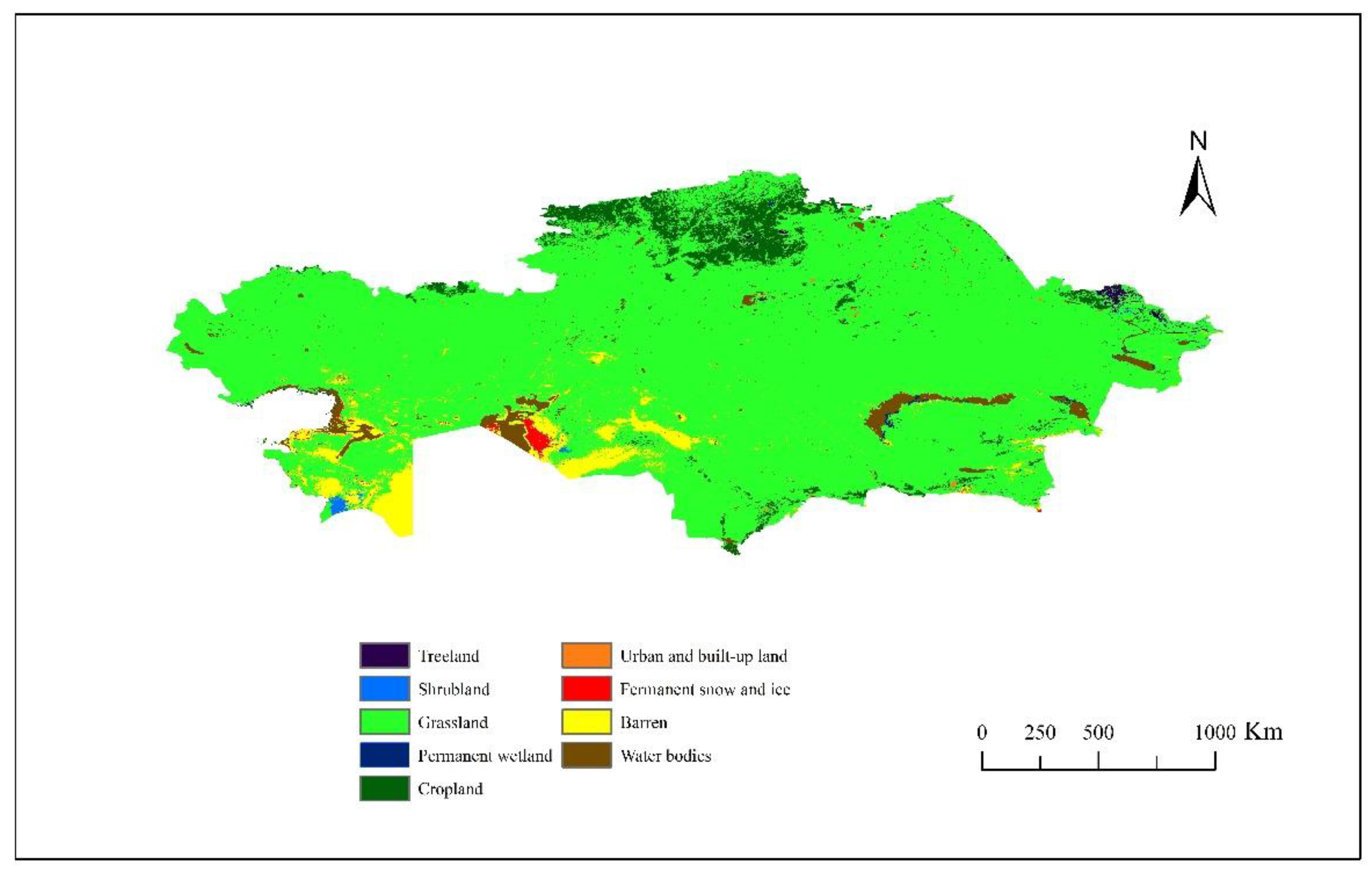
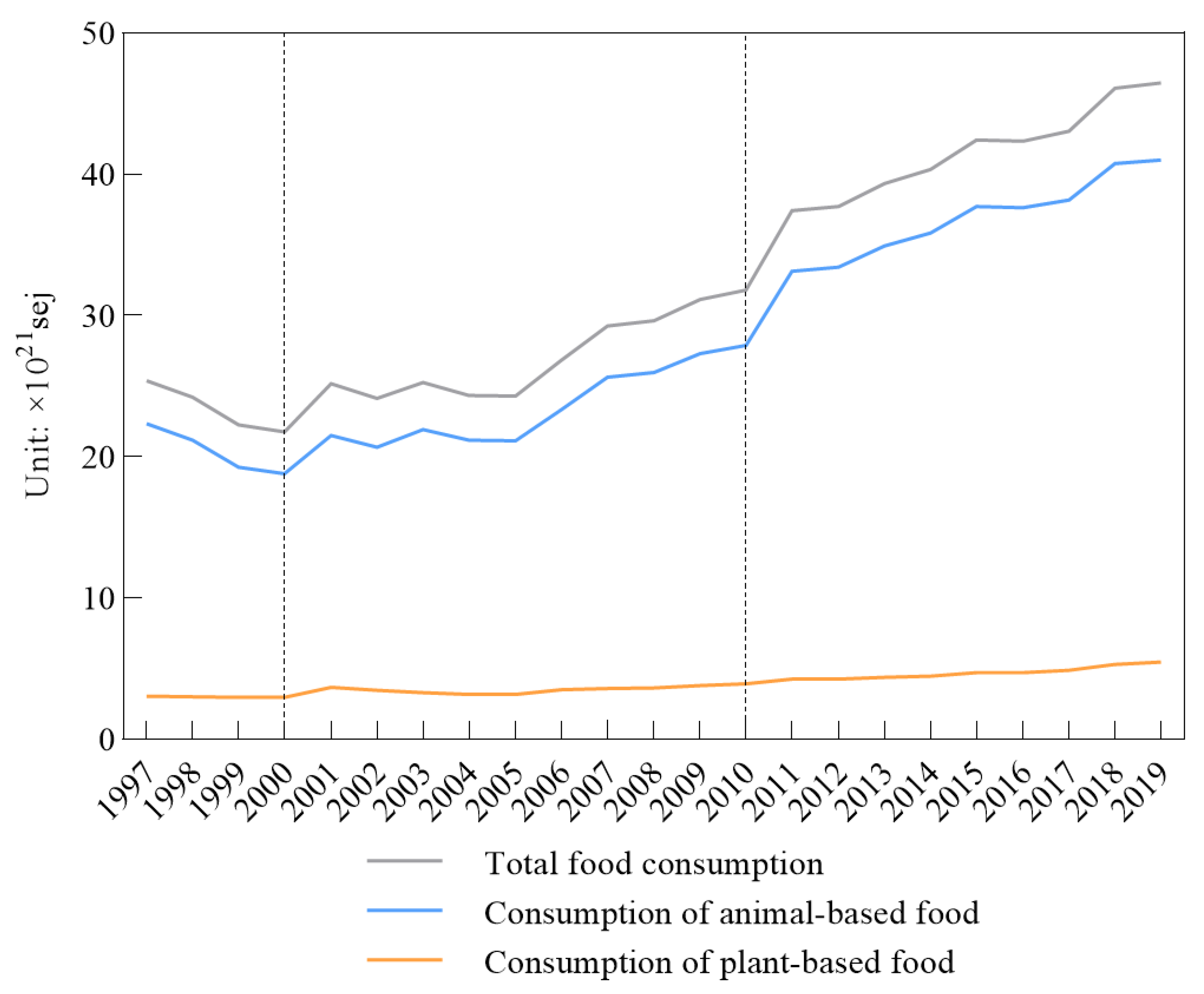
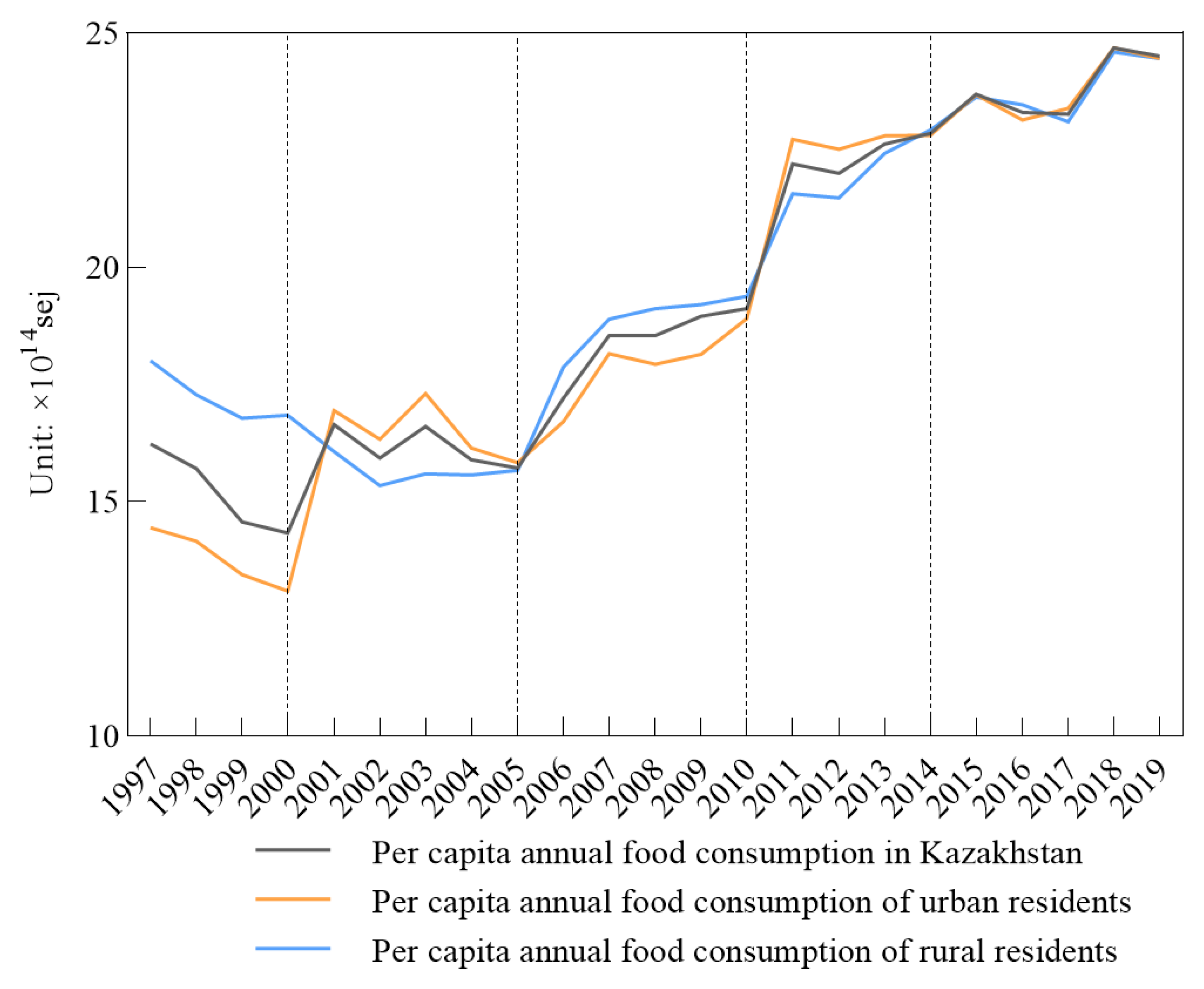



| Item | Energy Conversion Rate (J/kg) | Emergy Transformity (sej/J) |
|---|---|---|
| Wheat | 1.57 × 1010 | 6.80 × 104 |
| Rice | 1.55 × 1010 | 3.95 × 104 |
| Potato | 2.51 × 109 | 2.70 × 104 |
| Vegetable | 2.51 × 109 | 2.70 × 104 |
| Fruit | 3.30 × 109 | 5.30 × 105 |
| Sugar | 2.50 × 109 | 8.50 × 104 |
| Beef | 8.76 × 109 | 3.17 × 106 |
| Mutton | 1.41 × 1010 | 2.00 × 106 |
| Pork | 2.00 × 1010 | 1.70 × 106 |
| Chicken | 5.40 × 109 | 2.00 × 106 |
| Milk | 2.90 × 109 | 1.71 × 106 |
| Horsemeat | 1.10 × 107 | 2.00 × 106 |
| Fish | 5.40 × 109 | 2.00 × 106 |
| Egg | 8.30 × 109 | 2.00 × 106 |
Publisher’s Note: MDPI stays neutral with regard to jurisdictional claims in published maps and institutional affiliations. |
© 2021 by the authors. Licensee MDPI, Basel, Switzerland. This article is an open access article distributed under the terms and conditions of the Creative Commons Attribution (CC BY) license (https://creativecommons.org/licenses/by/4.0/).
Share and Cite
Jia, M.; Zhen, L. Analysis of Food Production and Consumption Based on the Emergy Method in Kazakhstan. Foods 2021, 10, 1520. https://doi.org/10.3390/foods10071520
Jia M, Zhen L. Analysis of Food Production and Consumption Based on the Emergy Method in Kazakhstan. Foods. 2021; 10(7):1520. https://doi.org/10.3390/foods10071520
Chicago/Turabian StyleJia, Mengmeng, and Lin Zhen. 2021. "Analysis of Food Production and Consumption Based on the Emergy Method in Kazakhstan" Foods 10, no. 7: 1520. https://doi.org/10.3390/foods10071520
APA StyleJia, M., & Zhen, L. (2021). Analysis of Food Production and Consumption Based on the Emergy Method in Kazakhstan. Foods, 10(7), 1520. https://doi.org/10.3390/foods10071520





